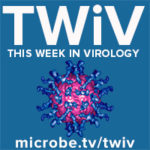Alessandro Sette joins TWiV to discuss the role of T cells in COVID-19, the finding that amino acid changes in SARS-CoV-2 variants of concern have a negligible impact on T cell reactivity in convalescent patients and vaccinees, and whether a next generation vaccine should include more viral proteins than spike.
Hosts: Vincent Racaniello, Alan Dove, Rich Condit, and Kathy Spindler
Guest: Alessandro Sette
Click arrow to play
Download TWiV 736 (73 MB .mp3, 122 min)
Subscribe (free): iTunes, Google Podcasts, RSS, email
Become a patron of TWiV!
Links for this episode
- Little impact of SARS-CoV-2 variants on T cell reactivity (bioRxiv) 6:28, 25:13
- NIDO 2021 Symposium 1:12:02
- Postdoctoral position at Towson University 1:15:08
- ASV hosts free COVID-19 Vaccine Education Town Halls (register here) 1:12:38
- Letters read on TWiV 736 1:30:06
- Timestamps by Jolene. Thanks!
Weekly Picks 1:46:29
Alan – The Disinformation Dozen report
Rich – No needle, but the damage was done
Kathy – Zinn art David Zinn
Vincent – Clueless Wall Street Journal Op-Ed Endorses PACE as “Prevailing View” Among Docs
Listener Picks
Justin – Finnish astrophotographer spends 12 years creating a Milky Way mosaic
Intro music is by Ronald Jenkees
Send your virology questions and comments to [email protected]


HIV also has a much higher mutation rate than SARS-CoV2, further facilitating its ability to evolve resistance to individual hosts.
Aspirating before intramuscular injection used to be standard practice in vaccination. At some point in time it was concluded that it really didn’t have any merit because there are no large vessels in the usual sites (deltoid in adults and older kids, vastus lateralis in infants).
https://www.cdc.gov/vaccines/hcp/acip-recs/general-recs/administration.html
Bravo, Bravo, Alessandro! Excellent, clear explanation of T-cell roles in fighting infection.
I loved this episode! Cheerful Dante 🙂 or as Camus said “one must imagine Sisyphus happy’.
There is hope for us humans given all of you’s cheerful persistance, indefatigable curiosity and sheer blo0dy-mindedness 🙂
Questions (hopefully not too daft!): how do T cell and B cell responses interact especially with regards to memory of infection? Does a memory T cell implicate (sometimes;always;ever;never?) a corresponding memory B cell response. if so, what would be the mechanism, cytokines?
Is there a triaging energy-wise- T cell response less costly if effective, antibodies only if infection lasts (how long?) or damages (How much/where?)
Do self-reactive T cells and self-reactive B cells get eliminated in similar ways and would this also process have any way of feeding back/ interacting?
Additionally, could a T cell epitope recognised in Sars CoV 2 or vaccine ‘call up’ a related pre-existing but previously not pathological auto-antibody response? vis ‘Antinuclear Autoantibodies in Health: Autoimmunity Is Not a Synonym of Autoimmune Disease’, Pashnina et al.
In agammglobulinemia- does this point to antibodies being a double-edged sword in SARS CoV 2 infection and does this indicate that people under immuno-suppresant therapy may not always suffer severe Covid19? The long duration of infection in one case that was studied for variant emergence apart- I think that was a cancer patient rather than auto-immune though. Is anyone aware of studies along this line?
I am still intrigued by the difference in experience of the pandemic wrt to ethnicity as it plays out in migrated populations. Is this just age demographics at play or is there something else going on, maybe along the lines of increased prevalence of autoimmune pathology and e.g schizophrenia (hypothesised by some to be-at least partly- of immune etiology) found in this population as immigrant vs in originating locations. Could there be immune dysregulation in absence of host-adaption-related early-life pathogen exposures? (e.g survival of ‘Immune amnesia’ following measles infection as a goldilocks threshold for local immune fitness).